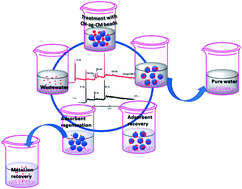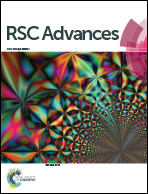Removal of Pb(ii) and Cd(ii) from wastewater using arginine cross-linked chitosan–carboxymethyl cellulose beads as green adsorbent
Abstract
A one pot approach has been explored to synthesize crosslinked beads from chitosan (CS) and carboxymethyl cellulose (CM) using arginine (ag) as a crosslinker. The synthesized beads were characterized by FTIR, SEM, EDX, XRD, TGA and XPS analysis. The results showed that CS and CM were crosslinked successfully and the obtained material (beads) was analyzed for adsorption of Cd(II) and Pb(II) by using batch adsorption experiments; parameters such as temperature, contact time, pH and initial ion concentration were studied. Different kinetic and thermodynamic models were used to check the best fit of the adsorption data. The results revealed that the kinetics data of the adsorption of Pb(II) and Cd(II) ions shows the best fit with the pseudo second order model whereas the thermodynamics data shows the best fit with the Langmuir isotherm with maximum adsorption capacities of 182.5 mg g−1 and 168.5 mg g−1 for Pb(II) ions Cd(II) ions, respectively. For the recovery and the regeneration after the one use of the beads, several adsorption–desorption cycles were carried out to check the reusability and recovery of both the metal ion and the adsorbent without the loss of maximum adsorption efficiency.

- This article is part of the themed collection: Editors' collection: Environmental chemistry: Pollution control


 Please wait while we load your content...
Please wait while we load your content...